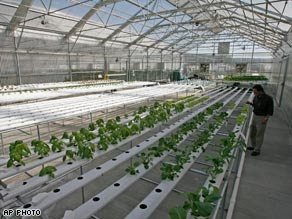Terry Fujimoto sees the future of agriculture in the exposed roots of the leafy greens he and his students grow in thin streams of water at a campus greenhouse. The program run by the California State Polytechnic University agriculture professor is part of a growing effort to use hydroponics -- a method of cultivating plants in water instead of soil -- to bring farming into cities, where consumers are concentrated.
 Because hydroponic farming requires less water and less land than traditional field farming, Fujimoto and researchers-turned-growers in other U.S. cities see it as ideal to bring agriculture to apartment buildings, rooftops and vacant lots. "The goal here is to look at growing food crops in small spaces," he said. Long a niche technology existing in the shadow of conventional growing methods, hydroponics is getting a second look from university researchers and public health advocates. Supporters point to the environmental cost of trucking produce from farms to cities, the loss of wilderness for farmland to feed a growing world population, and the risk of bacteria along extensive, insecure food chains as reasons for establishing urban hydroponic farms.
Because hydroponic farming requires less water and less land than traditional field farming, Fujimoto and researchers-turned-growers in other U.S. cities see it as ideal to bring agriculture to apartment buildings, rooftops and vacant lots. "The goal here is to look at growing food crops in small spaces," he said. Long a niche technology existing in the shadow of conventional growing methods, hydroponics is getting a second look from university researchers and public health advocates. Supporters point to the environmental cost of trucking produce from farms to cities, the loss of wilderness for farmland to feed a growing world population, and the risk of bacteria along extensive, insecure food chains as reasons for establishing urban hydroponic farms.
However, the expense of setting up the high-tech farms on pricey city land and providing enough year-round heat and light could present some insurmountable obstacles. "These are university theories," said Jim Prevor, editor of Produce Business magazine. "They're not mapped to things that actually exist." The roots of hydroponically produced fruits and vegetables can dangle in direct contact with water or be set in growing media such as sponges or shredded coconut shells. Most commercial operations pump water through sophisticated sensors that automatically adjust nutrient and acidity levels in the water.
Hydroponics are generally used for fast-growing, high-value crops such as lettuces and tomatoes that can be produced year-round in heated, well-lit greenhouses. So far, production is not large enough for the U.S. Department of Agriculture to track.
Get full story at CNN.

Comments